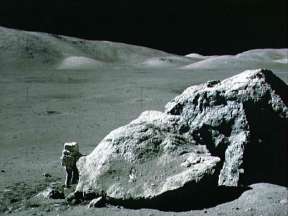geotimesheader
News Notes
Planetary geology
Nowhere
to hide for the Man on the Moon
 Since
the days of the Apollo program, researchers have known that, nearly
4 billion years ago, large impacts created many of the the Moon’s basins.
Yet with the limited evidence brought back from NASA and Soviet missions,
researchers have had difficulty deciphering the basins’ origins: Were the
impacts from a cataclysmic event, or were they the tail end of a several-hundred-million-year
rain of terror?
Since
the days of the Apollo program, researchers have known that, nearly
4 billion years ago, large impacts created many of the the Moon’s basins.
Yet with the limited evidence brought back from NASA and Soviet missions,
researchers have had difficulty deciphering the basins’ origins: Were the
impacts from a cataclysmic event, or were they the tail end of a several-hundred-million-year
rain of terror?
[At right: Apollo astronaut approaches a boulder
on the surface of the Moon. NASA]
A study in the Dec. 1 issue of Science presented the strongest
evidence in three decades for an almost sudden cataclysm, not a protracted
assault. The researchers show that impact melts in lunar meteorites —
rocks from regions astronauts or spacecraft never visited — have roughly
the same 3.9 billion-year age as impact melts collected during the Apollo
and Luna missions. Defying predictions, none of the newly dated specimens
show evidence of impacts older than 3.9 billion years.
Barbara Cohen of the Planetary Geosciences Institute at the University
of Tennessee at Knoxville, with Tim Swindle and David Kring of the University
of Arizona at Tucson, used Argon-Argon dating techniques to examine more
than 30 impact melts in four lunar meteorites. Because they did not observe
any melts younger than 3.9 billion years, their research supports the Lunar
Cataclysm hypothesis, which contends that more than 1,700 large impacts
pummeled the Moon 3.9 billion years ago in a crisis unlike any it had experienced
since its formation.
In addition, by showing that the meteorites have different chemical
signatures than Moon rocks collected during the Apollo and Luna missions,
Cohen and her colleagues presented evidence that the cataclysm was not
a localized event. Confirming the scale of the disaster lends support to
theories that impactors may also have assaulted other inner solar system
bodies, including Earth.
Bill Hartmann of the Planetary Sciences Institute asks if there was
some strange bombardment 4.0 billion years ago or whether early evidence
of large impacts was simply wiped out by cratering and pulverization. Hartmann
and others suggest that the cataclysm may have been the last major push
in a long history of pulverization, an event that erased earlier impact
evidence.
“Maybe what we are looking at,” he says, “is a declining early intense
bombardment, solar-system wide.” Spiking this decline might be periods
of increased activity from the breakup of planetesimals on planet-crossing
orbits. One of the spikes could have been a “moderate” catastrophe around
4 billion years ago, Hartmann says.
Cohen and her colleagues expected to find evidence for large impacts
before 3.9 billion years ago, “and that would be the end of it,” she says.
But they did not, and Cohen now believes that the cataclysm was a specific
event — one that came during a period of infrequent lunar impacts, not
during a period of continual, gradually declining bombardment.
And what of the possibility that earlier impact evidence was pulverized
beyond recognition? Erasure of earlier impact evidence would make sense,
she
adds, except that the Moon also contains small fragments from before 3.9
billion years ago that have survived to the present.
The results that Cohen, Swindle and Kring present do not conclusively
prove the cataclysm hypothesis, but they do show that meteorite impact
melt analyses are possible with modern equipment and techniques. As a result,
future studies of lunar rocks can draw from a substantially larger data
set: the 17 known lunar meteorites. And now that Cohen and her colleagues
have shown that the cataclysm occurred on a more global scale, research
is intensifying on what effect the impacts had on the even wider target
orbiting nearby: Earth.
Several researchers at UCLA, the Lunar and Planetary Institute, the
NASA-Ames Research Center and elsewhere have already investigated possible
effects of the cataclysm on an ancient Earth, including the effects on
early life — which may have had its origins around 3.9 billion years ago.
“Perhaps more intriguing,” Cohen says, “is the possibility of a similar
episode on another planet that may have harbored life at that early date:
Mars.” Cohen hopes that NASA’s plan to return martian samples in the next
few decades will give her a new opportunity to test the hypothesis.
Josh Chamot
Geotimes contributing writer
 Since
the days of the Apollo program, researchers have known that, nearly
4 billion years ago, large impacts created many of the the Moon’s basins.
Yet with the limited evidence brought back from NASA and Soviet missions,
researchers have had difficulty deciphering the basins’ origins: Were the
impacts from a cataclysmic event, or were they the tail end of a several-hundred-million-year
rain of terror?
Since
the days of the Apollo program, researchers have known that, nearly
4 billion years ago, large impacts created many of the the Moon’s basins.
Yet with the limited evidence brought back from NASA and Soviet missions,
researchers have had difficulty deciphering the basins’ origins: Were the
impacts from a cataclysmic event, or were they the tail end of a several-hundred-million-year
rain of terror?
